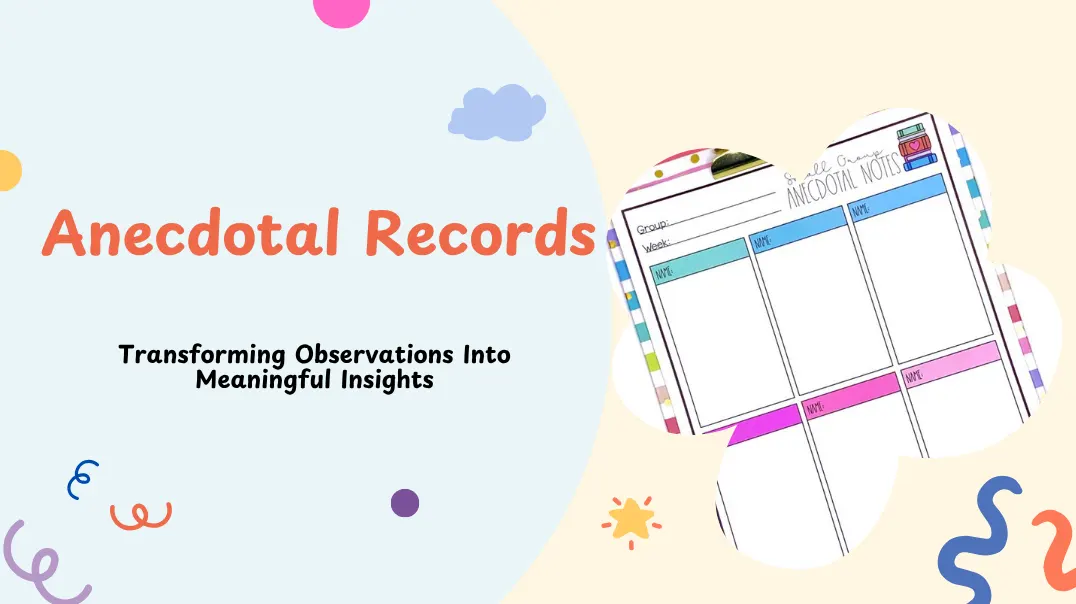Are you really making the most of your anecdotal records to document what matters in your okul öncesi sınıfı? Are you often jotting down notes but unsure if they truly reflect the child’s learning journey? Have you ever questioned whether your use of Anecdotal Records is meaningful, accurate, or even helpful in shaping your teaching strategies? Do your observations lead to insights, or are they just filling folders?
Anecdotal Records are short, factual notes that capture specific moments in a child’s day. These records help early childhood educators track development, understand behavior patterns, and make more informed teaching decisions. Whether used for daily planning, parent communication, or developmental assessments, Anecdotal Records transform fleeting moments into valuable educational insights.
If you’re not using anecdotal records yet—or not using them effectively—you’re missing out on one of the most insightful tools in early education. This guide explains how to transform informal notes into meaningful data to inform planning, communication, and management.
What is Anecdotal Record?
Anecdotal records are short, narrative-based observations that document specific incidents of a child’s behavior, learning, or social interactions in the classroom. Unlike formal assessments, they rely on descriptive, objective accounts of what a teacher sees and hears. The purpose is to capture the nuances of a student’s actions and responses, enabling educators better to understand individual learning styles, progress, and needs.
Used primarily in early childhood education, anecdotal records allow educators to observe without interference, enabling a natural flow of behavior. Their simplicity and effectiveness have made them an essential tool in classrooms worldwide, especially when assessing emotional, social, cognitive, and physical development.
The Origin and Evolution of Anecdotal Records
Anecdotal records date back to early educational theorists like Maria Montessori Ve Jean Piaget, who emphasized observation as a critical tool in understanding child development. Over time, what began as informal notes evolved into a more structured form of documentation, adopted by preschool educators, researchers, and caregivers. Today, they are widely integrated into curriculum planning and child assessment protocols.
Key Components of Anecdotal Records
A well-written anecdotal record should be:
- Objective: Descriptions must be free of personal opinion or bias.
- Specific: Include who was involved, what happened, where, and when.
- Concise: Focus on a single event or behavior in a manageable length.
- Descriptive: Use sensory details to paint a vivid picture.
- Chronological: Present information in the order it occurred.
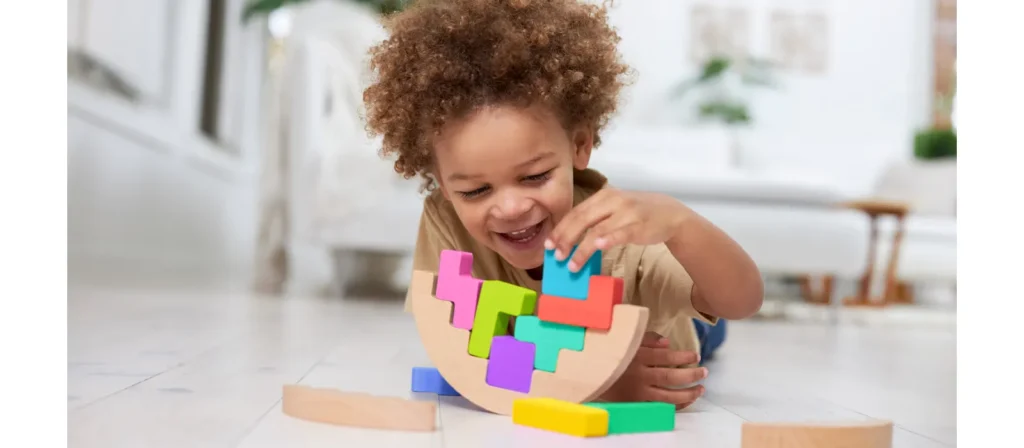
When Should Anecdotal Records Be Used?
Anecdotal records are flexible and can be used throughout the school day without interrupting routines. The goal is not to track every child at every moment, but to build a collection of small, meaningful observations that, over time, form a rich picture of development.
They are best used:
- During free play or center time
- İçinde outdoor environments
- While children are problem-solving or negotiating
- In routines (e.g., snack time, clean-up)
- When new behaviors appear
- When tracking an emerging skill
The most insightful records often come during natural interactions. They are spontaneous and real, reflecting authentic learning moments.
Collect Your Data
The first step in using anecdotal records is collecting real-time data. Teachers need to stay vigilant, watch closely for key learning moments, and be prepared to record what they observe. Data collection should be spontaneous and unfiltered, descriptive rather than interpretive.
- Be Ready at All Times
Keep a notebook, sticky notes, or a digital device within reach during class. Spontaneous observations often reveal the most authentic behaviors. - Observe in Natural Settings
Collect data during regular classroom activities such as playtime, group projects, or independent work. Authentic contexts yield more accurate insights. - Stay Objective and Non-Judgmental
Record only what you see and hear without making assumptions or interpretations. Avoid using adjectives or labels that suggest opinion. - Capture the Context
Include the setting, time, and situation in your notes. Understanding the environment provides essential context for interpreting behavior. - Document Behaviors, Not Feelings
Instead of writing “She was angry,” describe the actions: “She clenched her fists, raised her voice, and turned away from the group.” - Identify All Participants
If the behavior involves peers or adults, include their names or roles to establish context and relational dynamics.
Organize Your Data
Once data is collected, the next task is organizing it. Teachers can categorize records by student, subject area, behavioral domain (social, emotional, academic), or developmental goals. This organization is critical for identifying trends, tracking progress, and compiling comprehensive student profiles. A well-maintained record system transforms raw observations into meaningful information that guides instructional decisions.

Why Are Anecdotal Records Important?
Anecdotal records carry immense significance in education. They support holistic, individualized teaching practices by providing educators with concrete evidence of student development and behavior. More than just notes, these records are foundational elements of responsive teaching and formative assessment.
1. Personalize Learning
One major strength of anecdotal records is their ability to personalize learning. Teachers can adjust instructional strategies based on observed behaviors, catering to students’ preferred learning styles and paces. For instance, if a student consistently engages in kinesthetic activities but struggles with reading aloud, a teacher may introduce more movement-based literacy tasks.
2. Understand Personal Development
These records reveal much about emotional, social, and bilişsel gelişim. A child who frequently helps peers may be demonstrating leadership qualities. Another who avoids group work might need support in developing social skills. By observing such behaviors in context, teachers gain a deeper understanding beyond what a test score provides.
3. Promote Early Intervention
Anecdotal observations are crucial for identifying early signs of learning disabilities, behavioral disorders, or emotional distress. Teachers who track patterns over time are better equipped to initiate interventions, involve specialists, and support families with documentation and guidance.
4. Track Developmental Milestones
Especially in early childhood education, anecdotal records help monitor whether students are meeting age-appropriate developmental milestones. Educators can document language development, fine motor skills, and cognitive progress through daily observations rather than relying solely on benchmarks.
5. Promote Communication with Families
Well-documented anecdotal records enhance parent-teacher communication. Rather than offering vague feedback, teachers can share specific examples of student behavior, making progress or concerns clearer to families. This transparency builds trust and fosters a team approach to supporting the child.
6. Personalize Assessment
By complementing traditional evaluations, anecdotal records offer a fuller picture of student achievement. They bring subjectivity into balance with objectivity, allowing assessment to reflect not just what a student knows, but how they learn and grow. This leads to more equitable and humanized grading practices.

Advantages and Disadvantages of Anecdotal Records
While powerful, anecdotal records are not without limitations. Understanding their strengths and challenges ensures more effective and appropriate use in the classroom.
Advantages of Anecdotal Records
- Authenticity: They capture real behaviors in authentic contexts, not simulated responses.
- Personalization: Observations provide a student-specific lens, accommodating diverse learning needs.
- Holistic View: Records encompass cognitive, social, and emotional domains.
- Formative Insight: They support ongoing instructional adjustments.
- Communication: Useful in reporting and conferencing with parents or specialists.
- Documentation for Support Services: Serves as evidence for referrals, interventions, or evaluations.
- Esneklik: Can be used across different activities and age groups
- Supports multiple stakeholders: Useful for teachers, therapists, and parents
Disadvantages of Anecdotal Records
- Zaman tükeniyor: Recording and analyzing observations regularly can strain already busy teachers.
- Potential for Bias: Without training, subjective interpretations may creep into records.
- Inconsistency: Teachers may vary in how and when they document, leading to uneven data quality.
- Data Management: Without an organized system, records can become cluttered or underutilized.
- Sınırlı Kapsam: Anecdotal records do not easily scale to assess entire classrooms quickly or quantitatively.
Despite these challenges, the benefits often outweigh the drawbacks when anecdotal records are implemented thoughtfully and systematically.
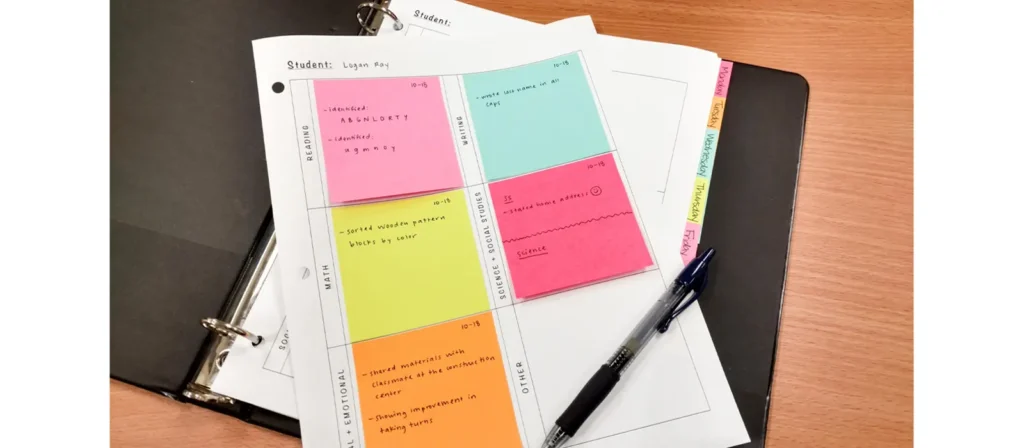
What Is the Anecdotal Record Method?
The anecdotal record method is a qualitative assessment tool involving detailed, written observations of student behavior. These records are brief, focused narratives that describe what a student said or did in a specific context. Unlike checklists or rating scales, they provide context and allow for later reflection and analysis.
This method is grounded in developmental and constructivist educational theories that emphasize observing learners in natural settings. It is particularly valued in early childhood education but has growing applications in inclusive classrooms, differentiated instruction, and social-emotional learning frameworks.
The process includes observing the event, recording what happened using factual, descriptive language, and organizing the records to align with educational goals or student needs. The effectiveness of this method relies on the observer’s consistency, clarity, and objectivity.
How to Write an Anecdotal Record?
Writing adequate anecdotal records involves more than simply jotting down what happens in the classroom. It’s a skill that requires attention, clarity, and objectivity. High-quality records capture the essence of student behavior while avoiding interpretation or judgment. Here’s a step-by-step guide to developing strong, meaningful entries.
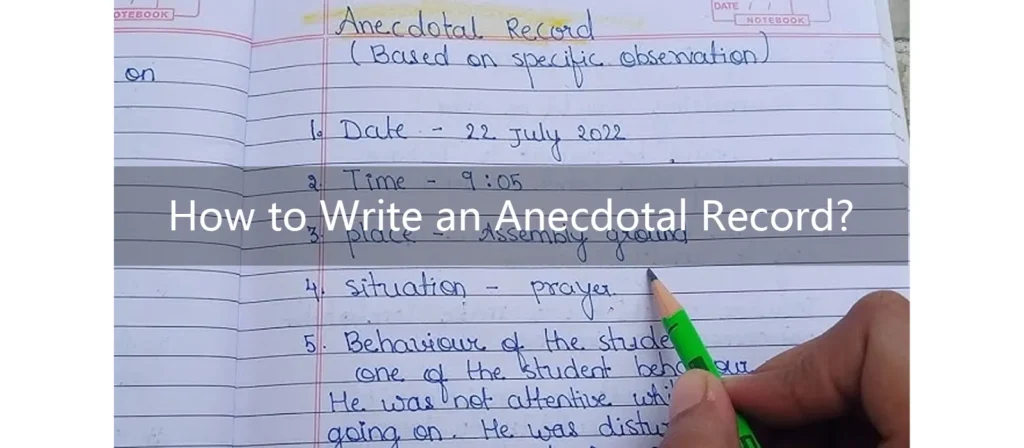
1. Choose Specific Behaviors to Observe
Not every moment needs documentation. Teachers should focus on behaviors relevant to learning objectives, developmental milestones, or classroom dynamics. For instance, if you’re focusing on communication skills, you might observe how a student initiates conversation or responds in group discussions. Observations should be intentional, not random.
2. Focus on Specific Events or Behaviors
Each record should describe a single, discrete event or behavior. Generalized statements like “He was acting out today” lack clarity and usefulness. Instead, note exactly what was said or done. For example: “At 10:45 AM, during independent reading, James threw his book on the floor, crossed his arms, and refused to respond when prompted.”
This level of specificity helps identify patterns when multiple records are reviewed over time.
3. Be Objective and Unbiased
Objectivity is essential. Descriptions must stick to facts—what was seen or heard, rather than assumptions. Avoid inserting your opinion, such as “She was being lazy,” and focus on what happened: “Samantha stared at her math worksheet without writing for 10 minutes and did not respond when asked if she needed help.”
This approach ensures your observations can be interpreted fairly by others, such as administrators or specialists.
4. Use Clear and Descriptive Language
The language used in anecdotal records should be vivid but neutral. Instead of saying, “He got furious,” write, “He shouted, ‘This is stupid!’ and pushed his chair back quickly before leaving the group.” Such language helps paint a mental picture and makes it easier to interpret behavior consistently.
Avoid abstract adjectives or adverbs like “happy,” “frustrated,” or “aggressively,” unless supported by descriptive action. Describe what the student did that led you to believe they felt that way.
5. Focus on Behaviors, Not Labels
Labelling students is a dangerous habit. Labels can bias future interpretations and affect how educators interact with a student. Avoid phrases like “troublemaker” or “lazy learner.” Stick with observable, recordable actions. Anecdotal records are not diagnoses—they’re snapshots.
For instance, rather than writing “Jack was disruptive,” write, “Jack left his seat five times during math and called out answers without raising his hand.”
6. Record Events in Real Time
Whenever possible, jot down notes as the behavior is happening or immediately after. Memory is fallible, especially in a busy classroom. Having shorthand or a quick note-taking system helps capture crucial details on the spot.
Later, those brief notes can be developed into fuller records. Delayed recording increases the likelihood of missed details or personal bias creeping in.
7. Maintain a Consistent Format
Using a consistent structure makes anecdotal records easier to read, organize, and analyze. A good format includes:
- Student’s name
- Date and time
- Setting or context
- Objective description of the event
- Optional reflection or follow-up
Standardized templates help educators stay efficient and prevent gaps in data. Digital tools often offer structured input fields that enforce consistency.
8. Keep It Clear and Concise
While anecdotal records should be detailed, they also need to be manageable. Aim for 3–6 sentences that communicate the key points. Overly lengthy or rambling entries can bury the vital information. Brevity helps focus on what matters—student behavior in context.
Here’s an example:
Student: Noah
Date: March 22
Time: 2:00 PM
Context: Science group activity
Observation: Noah asked his group members, “What do you think will happen if we add more salt?” He then recorded responses on the chart and took turns pouring materials without prompting.
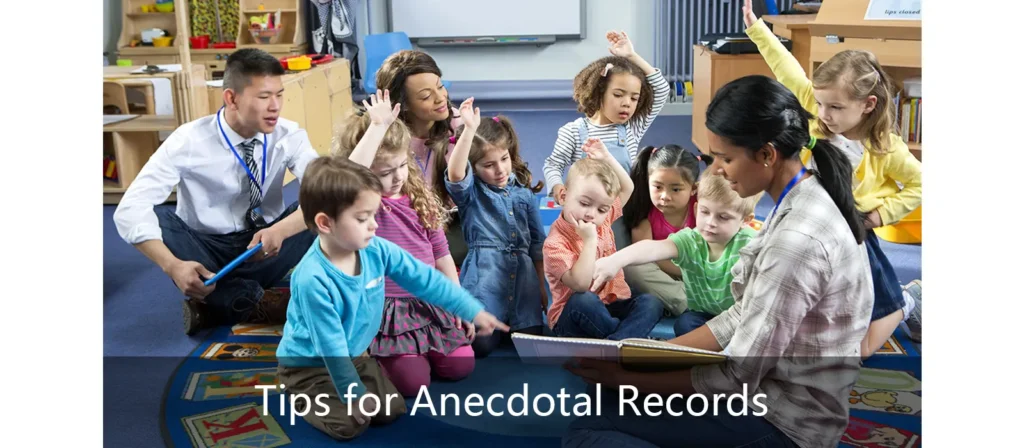
Tips for Making Anecdotal Records
Creating high-quality anecdotal records requires thoughtful planning, precision, and familiarity with observation techniques. To ensure accuracy, objectivity, and consistency, educators can adopt a variety of best practices tailored to both individual and group settings.
1. Familiarize Yourself with Assessment Tools and Systems
Understanding the purpose of anecdotal records within the larger framework of formative assessment is essential. Educators should explore their institution’s tools, templates, and digital systems to streamline data entry and ensure compatibility with other documentation efforts.
2. Create a List of Common Abbreviations
Time is limited in a classroom. To streamline your note-taking, create a personal list of abbreviations:
- “C” for child
- “AA” for adult assistance
- “OOB” for out of bounds
- “PITC” for play in the corner
As long as they’re consistent and understood by others on your team, abbreviations save time without sacrificing clarity.
3. Practice Writing Anecdotal Records
Like any skill, writing anecdotal records improves with practice. Educators should review real examples, write drafts, and compare notes with colleagues to refine clarity, objectivity, and descriptive quality. Regular rehearsal leads to greater speed and precision during actual classroom scenarios.
4. Plan Which Children to Observe
Rather than trying to observe all students every day, rotate your focus. Divide your class into groups and focus on a few children per day. This ensures balanced coverage and keeps the task manageable.
Create a schedule or tracking chart to record when each child was last observed.
5. Pay Attention to the Environment and Context
The setting in which a behavior occurs can profoundly influence its interpretation. Observations during structured learning versus free play may differ significantly. Educators should note environmental factors like peer interaction, available resources, or emotional climate to contextualize student actions accurately.
6. Choose Specific Focus Points
Rather than attempting to document everything, teachers should identify developmental areas of interest—language use, problem-solving, cooperation—and focus their observations accordingly. This keeps data purposeful and aligned with learning objectives.
If you’re using anecdotal records for assessment, tie your observations to developmental goals:
- Language and communication
- Fine or gross motor skills
- Emotional regulation
- Social skills
7. Write an Anecdotal Record About a Group Activity
Observing group dynamics can reveal insights into leadership, cooperation, conflict resolution, and peer interaction. During activities like block building, art projects, or snack time, look for how children relate to each other:
- Who leads?
- Who follows?
- Who resolves problems?
These interactions are powerful indicators of social development.
8. Purposefully Prepare Items for a Learning Center
Sometimes, setting up the right environment helps elicit valuable observations. For example, if you’re interested in tracking problem-solving, add puzzles of varying difficulty to the math area. If you’re looking at communication, add a pretend restaurant to dramatic play.
This intentionality can make your records more targeted and insightful.
9. Reflection and Review
Taking time to reflect on recorded observations helps teachers identify patterns and refine instructional strategies. Reviewing anecdotal records regularly—individually or with teaching teams—fosters deeper insights and more responsive planning.

Anecdotal Record Examples
Understanding the difference between objective and subjective observation is critical in anecdotal writing. The following examples illustrate unbiased and biased entries to guide educators in developing clear and adequate records.
Unbiased Anecdotal Record Example
- Date: April 12, 2025
- Time: 9:45 AM
- Location: Reading Center
- Observation: Emma selected a picture book from the shelf, sat on the rug, and read aloud for six minutes. She sounded out unfamiliar words and paused to look at illustrations. When a peer approached, she asked, “Do you want to read this with me?”
- Analysis: Emma demonstrates growing independence in literacy and developing social skills through shared reading invitations.
Biased Anecdotal Record Example
- Date: April 12, 2025
- Time: 9:45 AM
- Location: Reading Center
- Observation: Emma was bored and didn’t try reading her book. She distracted others and was not interested in learning.
- Analysis: Emma lacks focus and motivation in literacy activities.
In the biased example, the teacher uses interpretation (“bored,” “not interested”) rather than recording observable actions. Objective language ensures fairness and clarity in documentation.

Organize and Manage Your Anecdotal Records
To maximize the value of anecdotal records, they must be systematically organized and managed. A disorganized collection of notes is far less helpful than a structured, categorized, and easily accessible system.
1. Choose an Appropriate Format
The first step in organizing anecdotal records is selecting a format that suits the teaching context and available resources. Options include:
- Paper-based notebooks or binders: These allow flexibility and immediacy but require careful labeling and secure storage.
- Digital documents (Google Docs, Word): Easy to update and share, especially in collaborative environments.
- Mobile apps and educational platforms (e.g., Seesaw, Brightwheel, HiMama): These offer structured templates, multimedia support, and tagging features for efficient sorting and sharing.
The format chosen should allow for consistent use, protect student privacy, and make it easy to retrieve records.
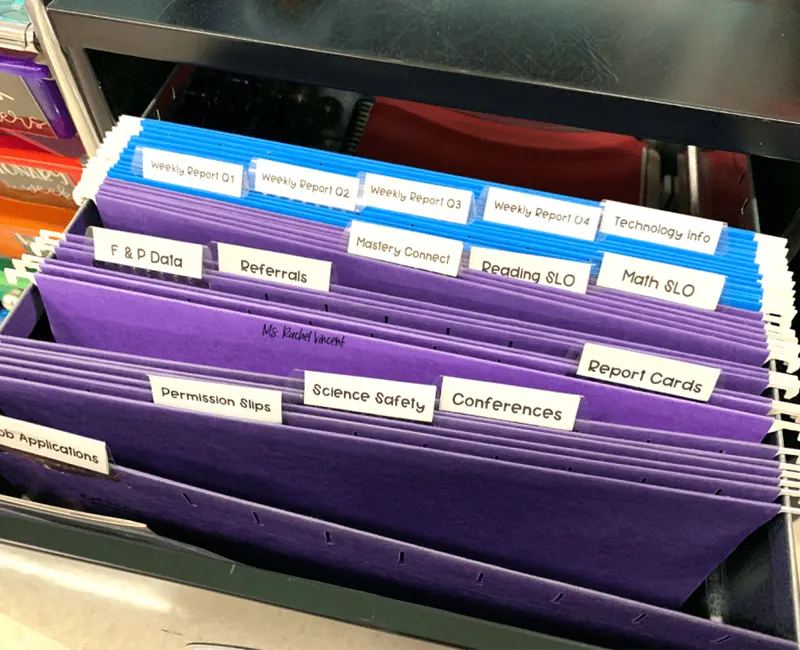


2. Create Categories and Tags
RCategorizing records helps make sense of data over time. Effective categorization ensures that similar observations can be grouped for comparison, trend analysis, or reporting. Some suggested categories and tags include:
- Developmental domains: Cognitive, social-emotional, physical, language, and adaptive behavior.
- Curriculum areas: Literacy, math, science, art, and physical education.
- Behavioral traits: Cooperation, persistence, independence, empathy.
- Classroom contexts: Individual work, group projects, transition times, outdoor play.
Tagging each entry with one or more relevant labels ensures that educators can quickly filter data and compile reports that align with learning goals or developmental checklists.
3. Use a Consistent Structure
Stick to a structure: Date, Time, Location, Observation, Analysis. This makes reading and comparing records easier, especially for long-term analysis.
4. Update Your Records Regularly
Regular updates are essential to maintain an accurate picture of each student’s progress. Stale or outdated observations can mislead educators and fail to reflect recent developments. Establishing a routine for updating records—such as dedicating time every afternoon or allocating specific days for documentation—helps ensure that no child is overlooked.
Additionally, using brief shorthand notes during the day and expanding them later into full anecdotal entries can make regular updates more feasible within a busy schedule.

5. Share and Collaborate
Anecdotal records become even more valuable when they are shared among educators working with the same students. Teaching assistants, subject specialists, and co-teachers often witness different aspects of a child’s development. Collaborative record-keeping enables multiple perspectives and helps build a more complete student profile.
Establishing protocols for shared documentation—who can write, review, or edit records—ensures consistency and accountability. Digital tools are invaluable for collaborative access and updates.
6. Review and Analyze
Systematic analysis of anecdotal records allows educators to track progress, identify trends, and plan next steps. This process can include:
- Weekly or monthly reviews: Look for changes in behavior or learning that may indicate growth or concern.
- Thematic analysis: Group observations by category (e.g., social skills) to identify patterns across different contexts.
- Progress tracking: Compare current records with past entries to evaluate development over time.
- Instructional planning: Use the data to adapt lesson plans, groupings, or intervention strategies.
Regular analysis transforms anecdotal records from static notes into a dynamic planning tool.
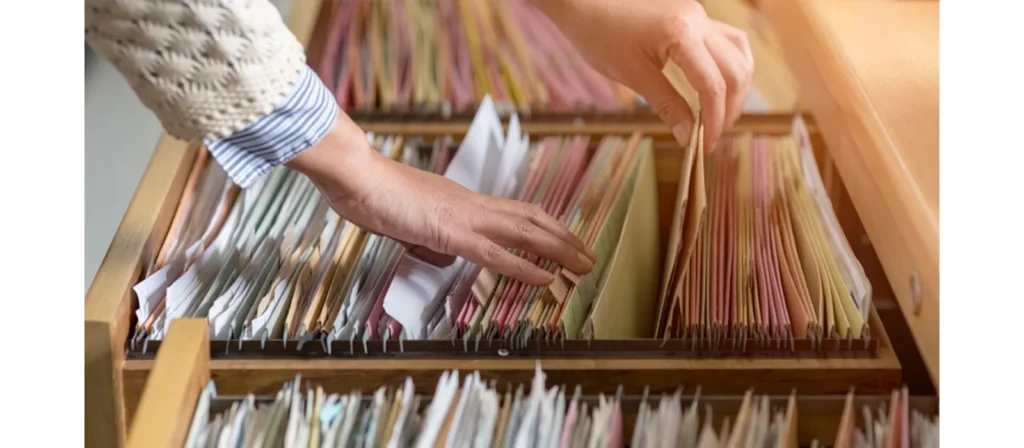
7. Respect Privacy and Confidentiality
Because anecdotal records contain sensitive information about children’s behavior, development, and interactions, safeguarding their confidentiality is paramount. Educators must:
- Secure physical records in locked drawers or cabinets.
- Password-protect digital files and apps.
- Restrict access to authorized personnel only.
- Avoid using full names in shared documents if not necessary.
- Never disclose observational data to others without proper authorization.
8. Consider Using Photos and Videos
While written observations form the core of anecdotal records, integrating visual media can enhance their depth and context. Photos and videos allow educators to:
- Capture moments that are difficult to describe in writing.
- Provide evidence during parent-teacher conferences or assessment meetings.
- Highlight specific developmental milestones or learning outcomes.
However, this must be done with explicit parental consent, clear storage guidelines, and adherence to privacy policies. Digital platforms that support secure multimedia uploads are ideal for this purpose.

How Do Anecdotal Records Work?
Anecdotal records function as real-time, narrative-based assessments that capture specific student behaviors or interactions. Teachers observe naturally occurring events, document them factually, and later use these records to inform their planning and instructional choices.
This method works best when integrated into a broader assessment framework. Teachers use the data to track student progress, identify learning needs, communicate with parents, and align observations with developmental goals or curriculum standards.
Anecdotal records work by capturing everyday moments in a child’s learning journey. When collected consistently, they allow educators to:
- Make data-informed decisions
- Recognize patterns over time
- Support individualized planning
- Identify areas for intervention
- Build comprehensive profiles for each child
They function best in combination with other tools like portfolios, developmental checklists, and child interviews. Ultimately, they work because they bring qualitative depth to educational assessment.
Difference Between Anecdotal Records and Checklists
| Bakış açısı | Anecdotal Records | Checklists |
|---|---|---|
| Doğa | Descriptive narratives | Binary yes/no indicators |
| Odak | Specific incidents and context | Predefined skills or behaviors |
| Esneklik | Open-ended, detailed | Structured, limited scope |
| Insight | Provides context and behavior patterns | Measures the presence or absence of traits |
| Kullanmak | Qualitative analysis | Quick overview of mastery |
| En İyisi İçin | In-depth understanding | Rapid assessment of benchmarks |
Difference Between Anecdotal Records and Running Records
| Bakış açısı | Anecdotal Records | Running Records |
|---|---|---|
| Zamanlama | Written after the event | Recorded in real-time |
| Length | Brief, focused snapshots | Continuous documentation |
| Content | Key incidents or behaviors | Every action or word over a period |
| Amaç | Document significant events | Track ongoing performance |
| Detail | Focus on critical events | Includes all details during observation |
Difference Between Anecdotal Records and Cumulative Records
| Bakış açısı | Anecdotal Records | Cumulative Records |
|---|---|---|
| Scope | Short-term, incident-based | Long-term, full student history |
| Format | Narrative entries | Academic and personal data |
| Kullanmak | Daily observation | Formal record-keeping |
| Amaç | Support formative assessment | Maintain permanent records |
| Erişilebilirlik | Used primarily by teachers | Accessed by school administrators |
What Is an Anecdotal Record Observation?
An anecdotal record observation is a written, factual account of a specific event observed in a child’s learning environment. It is designed to document spontaneous behaviors, interactions, skills, or emotions as they naturally occur. These observations are descriptive and narrative in nature, rather than evaluative or interpretative. They serve as a window into a child’s development by capturing real moments in real time, which can later be analyzed for patterns and growth.
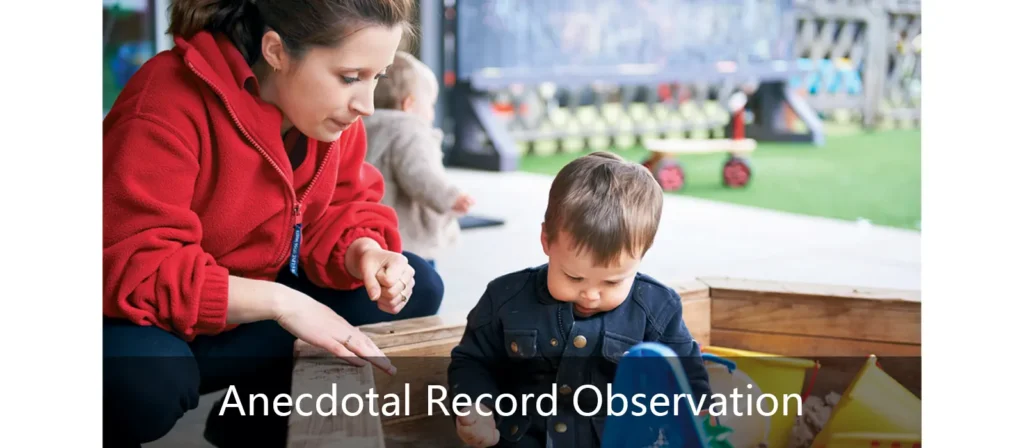
Other Observation Methods
While anecdotal records are invaluable, they are only one part of a comprehensive observation toolkit. Educators often employ multiple methods to capture a well-rounded view of student development. These include:
- Notes
Informal jotting of brief points during class to be expanded later into formal records. Quick and practical, but sometimes lacking detail if not promptly elaborated. - Photos
Used with consent, photographs can capture student engagement, classroom setups, or project stages. Visual evidence supports narratives and provides context for parents and administrators. - Running Records
Real-time, continuous documentation of a student’s behavior or activity over a defined period. More detailed than anecdotal records, often used in literacy instruction and behavior tracking. - Samples
Collections of student work (drawings, writing, projects) paired with written context or reflection. These help document progress and align with learning objectives.
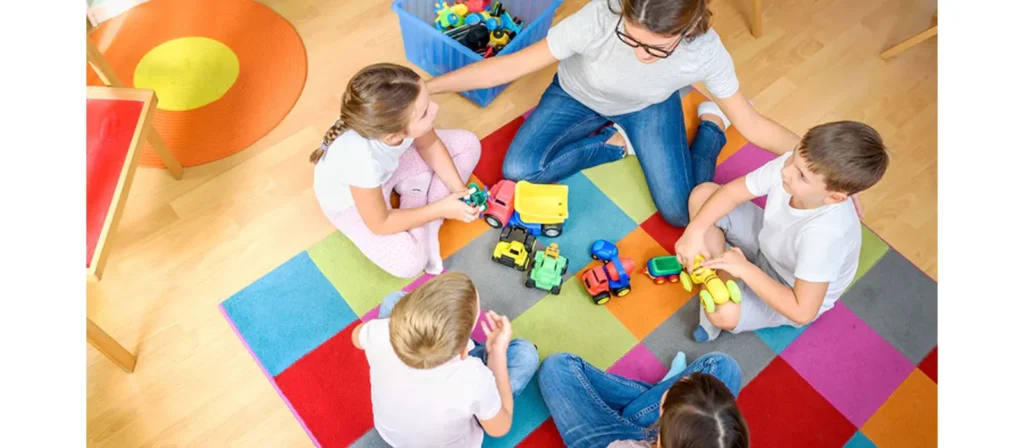
Using Anecdotal Records in the Classroom
Integrating anecdotal records into daily practice requires intention and organization. Start by deciding how many records you aim to collect each week and on whom. Assign specific days to observe confident children or domains of development.
Classroom setup can influence your success. Place observation tools like clipboards, sticky notes, or digital tablets in accessible spots. Designate one staff member per area to observe while others guide play.
Use Natural Times in the Day for Observation:
- Center activities
- Outdoor play
- Group time
- Transitions
- Snack and meal routines
Keep your records short and factual. At the end of the day or week, transfer them into a child’s file or digital system. Label by domain (e.g., social-emotional, language) and link to developmental indicators when possible.
After collecting observations, educators can use them to adjust instruction, design targeted interventions, or provide meaningful feedback. When patterns appear—such as a child consistently avoiding verbal participation—teachers can respond with strategies like peer pairing, role-play, or confidence-building activities.
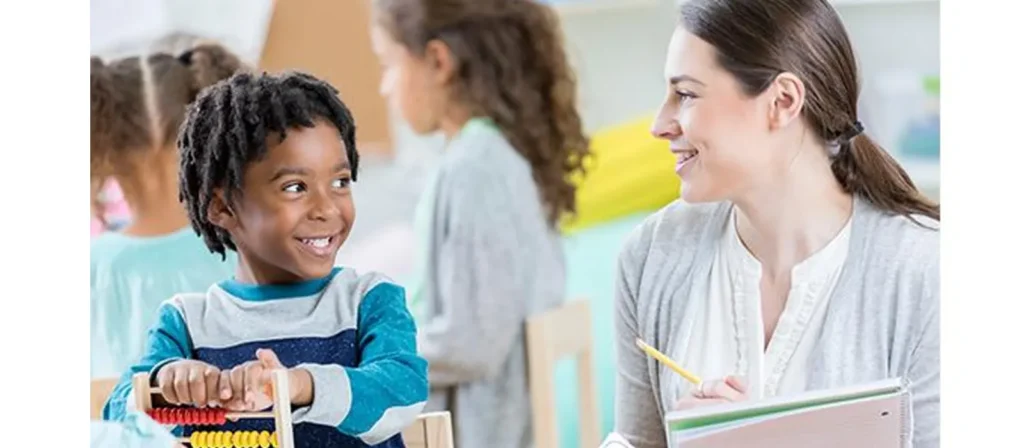
Benefits of Anecdotal Records for Educators
Anecdotal records offer substantial advantages to educators seeking to understand their students beyond test scores and academic tasks. Some key benefits include:
- Better Understanding of Each Child: Small moments reveal learning styles, emotional triggers, and developmental pace.
- Informed Instruction: Teaching becomes more targeted. You can group children by skill level or interest rather than by arbitrary age.
- Improved Classroom Management: Behavior patterns become clearer, helping educators intervene early or adjust the environment.
- Professional Growth: Observations encourage reflection, helping educators evaluate their teaching strategies and biases.
- Stronger Parent Communication: Sharing detailed, positive examples builds trust and engagement with families.
- Preparation for Assessment and Reporting: Records provide authentic evidence of learning, crucial during assessments or parent-teacher meetings.

How to Use Anecdotal Records for Evaluation?
Using anecdotal records for evaluation involves both qualitative interpretation and structured analysis. Though anecdotal entries are informal, they become powerful assessment tools when reviewed systematically and aligned with educational goals.
- Tracking Progress Over Time: Repeated entries about a child’s language, motor, or social skills show trends and improvement.
- Highlighting Developmental Delays: Patterns of behavior—or lack thereof—can signal a need for intervention.
- Connecting to Standards: Link observations to state or curriculum standards to inform reports.
- Supporting Summative Assessments: When preparing portfolios or end-of-term reports, anecdotal records serve as rich, authentic evidence.
- Guiding Documentation for Referrals: In cases of special needs concerns, detailed records help specialists understand context and support strategies.
To Evaluate Effectively:
- Set developmental goals based on observations.
- Organize records by domain or skill.
- Meet regularly with teaching teams to discuss trends.
- Use consistent formats for easy review.
Evaluation becomes less stressful and more meaningful when supported by daily observation, rather than last-minute assessments.
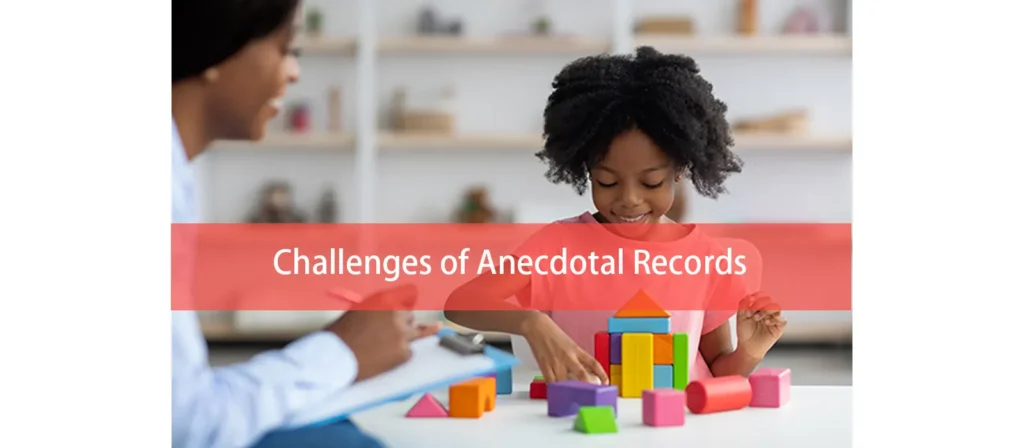
Challenges of Anecdotal Records
Despite their value, anecdotal records present several challenges, especially when not implemented systematically. Key difficulties include:
- Time Constraints
Observing, recording, organizing, and analyzing anecdotal data can be time-consuming. Without efficient systems, teachers may struggle to maintain regular documentation. - Risk of Subjectivity
Inexperienced observers may unintentionally include biases or interpretations in their records. Phrases like “She seemed sad” instead of “She sat quietly with her head down and didn’t respond” can reduce reliability. - Uneven Coverage
Without a tracking system, some students may receive more observational attention than others, leading to incomplete or biased data. - Data Management Issues
Storing, retrieving, and organizing hundreds of notes—especially without digital tools—can become overwhelming. Essential insights may get lost in cluttered or unstructured files. - Balancing Observation and Instruction
Teachers often feel torn between actively teaching and taking observational notes. It requires skill to observe while also facilitating lessons, especially in busy classrooms. - Privacy Concerns
Anecdotal records include sensitive information. Ensuring confidentiality and ethical use is essential, particularly when records are shared with other professionals or parents.
Solutions include:
- Providing professional development on unbiased documentation.
- Creating classroom systems that allocate observation roles and schedules.
- Using digital tools that streamline tagging and storage.
- Setting aside time in staff schedules for documentation and review.
Despite these challenges, the strategic use of templates, digital apps, and observation schedules can significantly ease the burden. With support and training, educators can integrate anecdotal record-keeping into their teaching practice without compromising instructional quality.
SSS
- How do you write a good anecdotal record?
Use objective, detailed descriptions, avoid interpretations, and include context such as time, setting, and activity. - Can anecdotal records be used for all age groups?
Yes, while common in early education, they are helpful at all levels to observe behavior, engagement, and growth. - How do anecdotal records support inclusive education?
They offer insights into individual learning needs and behaviors, helping teachers tailor support and ensure equity. - Are digital tools practical for recording anecdotal observations?
Yes, they enhance efficiency, accuracy, and storage while allowing multimedia documentation. - How often should teachers write anecdotal records?
While there’s no strict rule, aiming for one significant record per student every two weeks can offer balanced coverage without overwhelming teachers. - Can anecdotal records be used in report cards?
Yes, they enhance report cards by adding detailed, evidence-based observations that support academic and behavioral evaluations. - What tools help manage anecdotal records?
Apps like Seesaw, ClassDojo, and digital folders in Google Workspace allow teachers to record, organize, and share anecdotal data efficiently. - Can anecdotal records be helpful for classroom management?
Yes, anecdotal records can be extremely valuable tools for classroom management. By systematically documenting student behaviors, interactions, and responses over time, educators gain deep insights into the underlying patterns that influence classroom dynamics.
Çözüm
Anecdotal records remain one of the most effective tools for capturing the dynamic, complex, and deeply human aspects of student learning. By focusing on real-time, contextualized observations, teachers can support learners not just academically, but socially and emotionally as well.
When used thoughtfully, anecdotal observations lead to responsive teaching, targeted support, and deeper connections between educators, students, and families. While they require time and skill, their impact on individualized education is profound and lasting.

